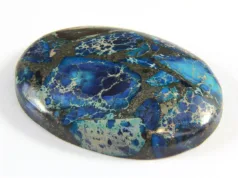Fuchsite, also known as chrome mica or green muscovite, is a variety of muscovite, which is a common form of mica. It gets its green color from the presence of chromium impurities. Fuchsite is often prized for its sparkling, shimmering appearance due to its fine crystal structure.
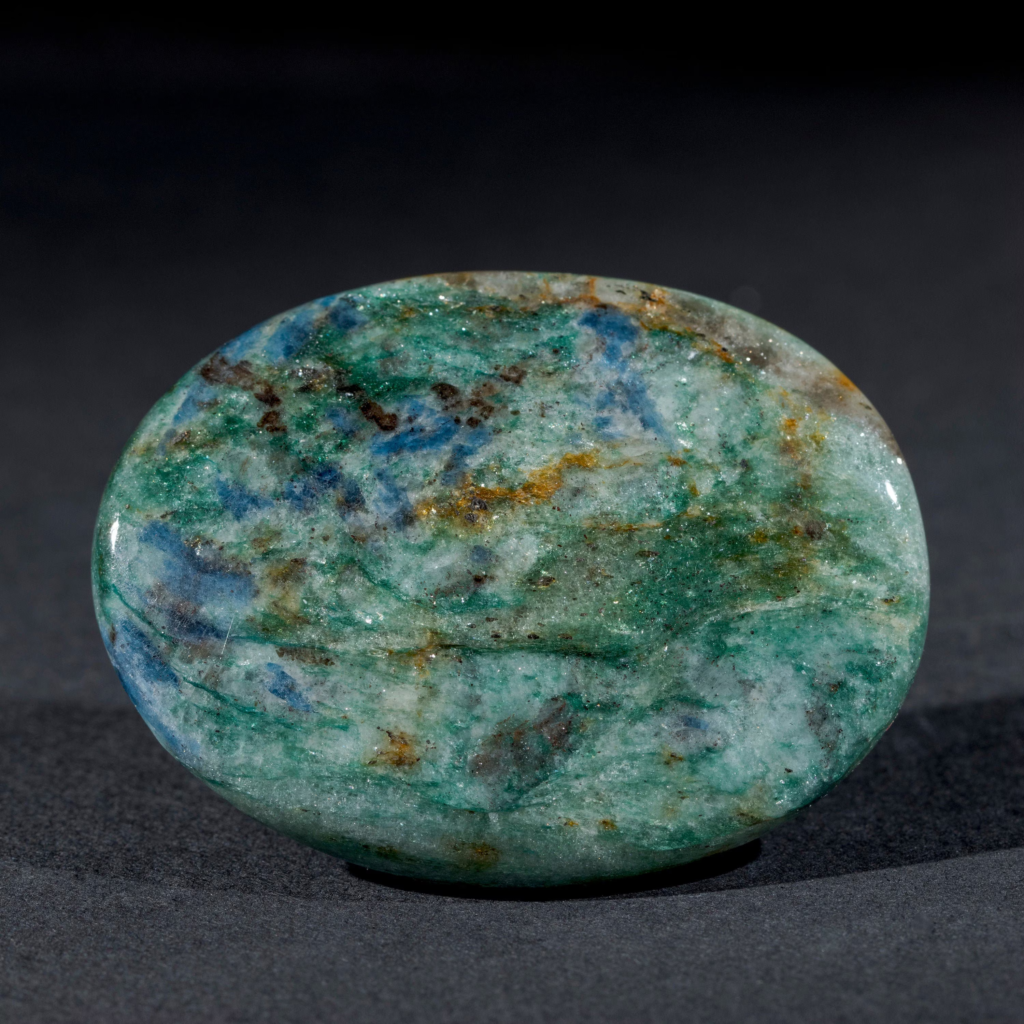
Definition and Composition:
Fuchsite is a mineral belonging to the mica group, characterized by its green coloration. Its chemical formula is K(Al,Cr)_2(AlSi_3)O_10(OH)_2, indicating its composition of potassium, aluminum, chromium, silicon, oxygen, and hydrogen. It typically forms in metamorphic rocks, often alongside minerals like quartz, albite, and garnet.
Geological Occurrence:
Fuchsite is commonly found in metamorphic environments, particularly within schist and gneiss formations. These rocks undergo intense heat and pressure during their formation, which facilitates the crystallization of minerals like fuchsite. It often occurs as small flakes or crystals within these rocks, contributing to their distinctive green coloration. Significant deposits of fuchsite have been found in regions such as Brazil, India, Russia, and Zimbabwe.
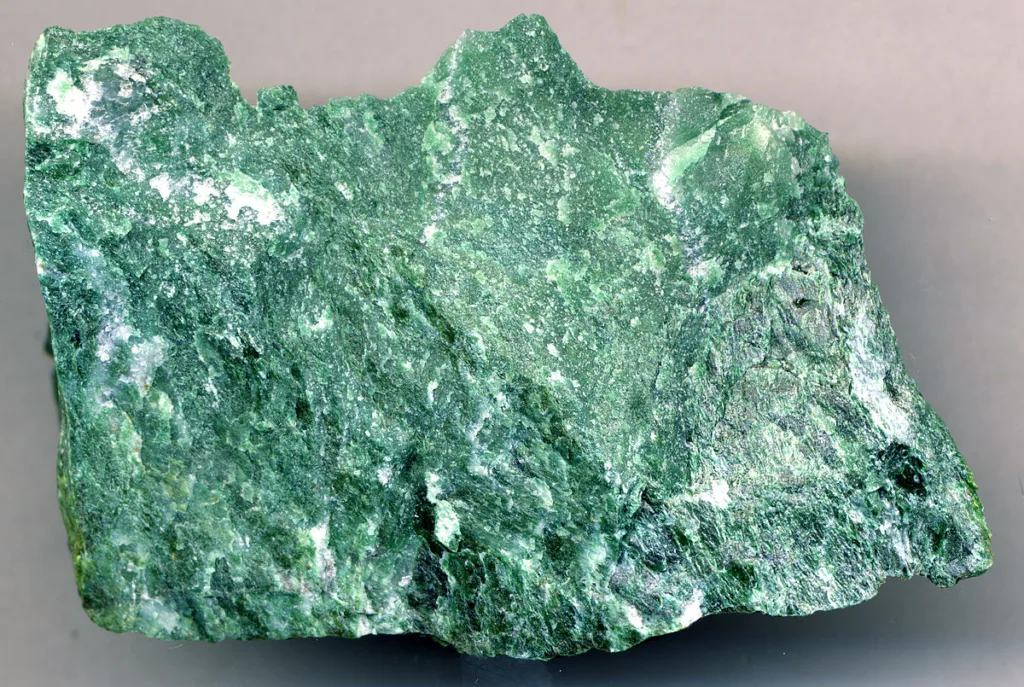
Significance:
Fuchsite holds both geological and metaphysical significance. Geologically, it serves as an indicator mineral, providing valuable insights into the conditions under which certain rocks formed. Its presence can indicate the presence of chromium, which has implications for understanding the geological processes that occurred in a particular area.
Metaphysically, fuchsite is believed to possess various healing and spiritual properties. It is often associated with promoting emotional balance, encouraging self-reflection, and fostering a sense of vitality and abundance. Some practitioners of crystal healing also believe that fuchsite can help alleviate stress, enhance intuition, and promote feelings of gratitude and compassion.
In jewelry and lapidary arts, fuchsite is valued for its attractive green color and its shimmering appearance. It is often cut and polished into cabochons, beads, or other ornamental objects. Due to its relatively soft nature, fuchsite is not typically used in high-wear jewelry pieces but is instead favored for its aesthetic appeal and metaphysical properties.
Physical Properties of Fuchsite

The physical properties of fuchsite can be described as follows:
- Color: Fuchsite is typically green, ranging from pale green to a deep emerald or forest green. The coloration is due to the presence of chromium within its crystal structure.
- Luster: It exhibits a vitreous to pearly luster when viewed in reflected light.
- Transparency: Fuchsite is usually translucent to opaque, depending on its thickness and impurities.
- Crystal System: Fuchsite crystallizes in the monoclinic crystal system, typically forming tabular or platy crystals. However, it often occurs as aggregates or masses of tiny crystals.
- Hardness: Its hardness ranges from 2 to 2.5 on the Mohs scale, making it relatively soft. This softness means that fuchsite can be easily scratched or damaged, limiting its use in certain applications.
- Cleavage: Fuchsite exhibits perfect basal cleavage, meaning it readily cleaves into thin, flexible sheets along its crystal planes. This cleavage is a characteristic property of mica minerals.
- Density: The density of fuchsite varies depending on its composition and any included impurities but typically falls within a range of 2.7 to 2.9 g/cm³.
- Streak: The streak of fuchsite, observed by rubbing it on an unglazed porcelain streak plate, is white.
- Fracture: Fuchsite exhibits uneven to conchoidal fracture, meaning it breaks irregularly or with curved surfaces.
These physical properties collectively contribute to the identification and characterization of fuchsite in both geological and lapidary contexts.
Chemical Composition
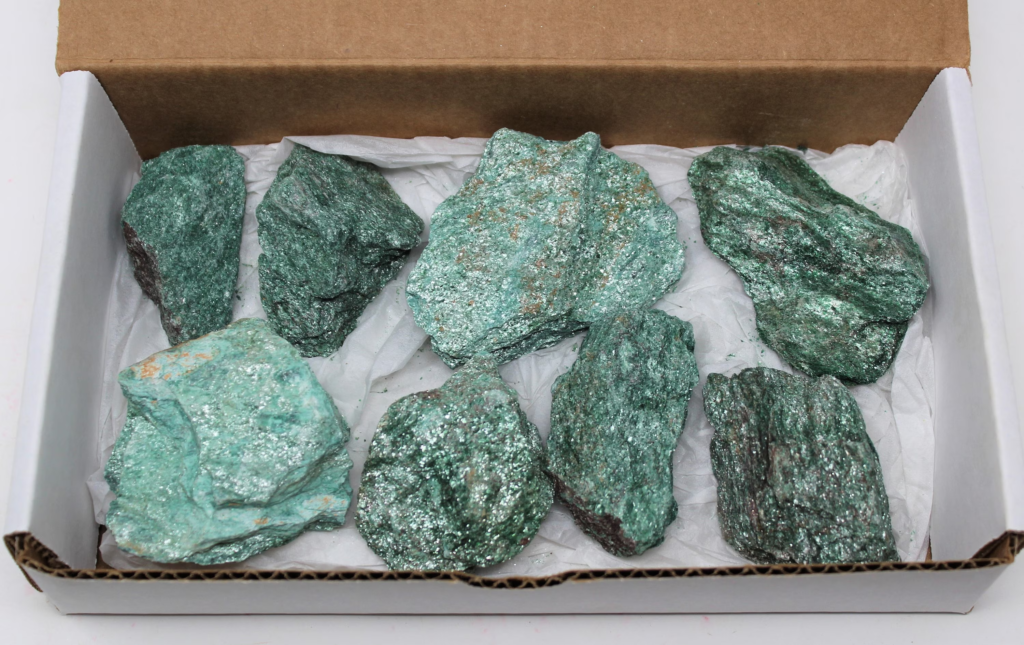
The chemical composition of fuchsite can be described using its mineral formula, which is:
K(Al,Cr)2(AlSi3)O10(OH)2K(Al,Cr)2(AlSi3)O10(OH)2
This formula indicates the presence of several elements:
- Potassium (K): This element is represented by the “K” in the formula and is an essential component of fuchsite.
- Aluminum (Al): Aluminum is represented by both “Al” in the formula. It contributes to the overall structure of the mineral.
- Chromium (Cr): Chromium is a trace element found in fuchsite, and its presence is responsible for the green coloration of the mineral.
- Silicon (Si): Silicon is represented by “Si” and is a key constituent of the silicate structure of fuchsite.
- Oxygen (O): Oxygen atoms form bonds with the other elements in the mineral, contributing to its overall structure.
- Hydroxide (OH): Hydroxide groups are present in the mineral’s structure, contributing to its physical and chemical properties.
The exact composition of fuchsite can vary depending on factors such as the specific geological environment in which it forms and the presence of impurities. However, the formula provided above represents the general chemical composition of fuchsite.
Geological Formation
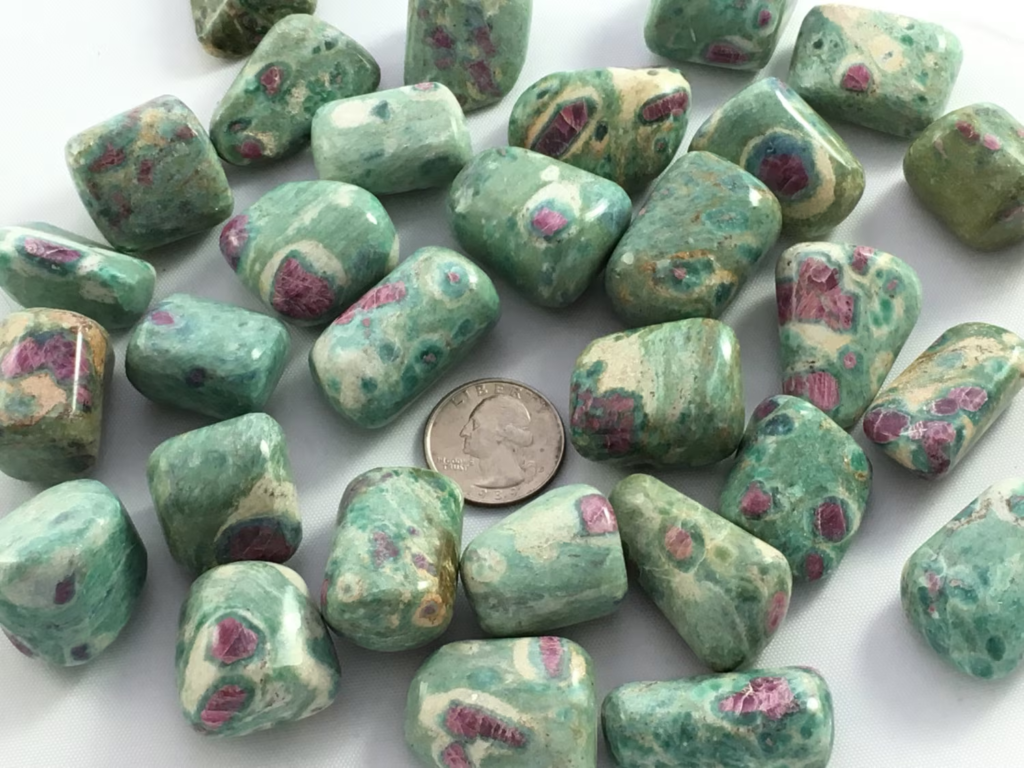
Fuchsite typically forms in metamorphic environments, where rocks undergo significant changes in response to heat, pressure, and chemical reactions. The geological formation of fuchsite involves a series of processes that transform precursor minerals into the distinctive green-colored mica.
- Parent Rock: Fuchsite commonly originates from precursor rocks rich in aluminum, silica, and potassium. These precursor rocks can include various types of shale, mudstone, or sedimentary rocks containing minerals like muscovite, biotite, or chlorite.
- Metamorphism: The precursor rocks undergo metamorphism, a process involving the alteration of mineralogy, texture, and chemical composition due to heat and pressure. Metamorphic conditions typically occur in the lower crust or upper mantle of the Earth’s crust.
- Hydrothermal Activity: During metamorphism, fluids rich in elements such as aluminum, chromium, and potassium may infiltrate the rock, introducing new chemical constituents into the mineral assemblage. These hydrothermal fluids can originate from sources such as magma chambers or circulating groundwater.
- Crystallization: Under the conditions of metamorphism and hydrothermal activity, fuchsite crystals begin to form. The presence of chromium impurities within the mica structure imparts the characteristic green color to the mineral. Crystallization may occur as individual flakes or aggregates within the metamorphic rock matrix.
- Rock Deformation: The metamorphic rocks containing fuchsite may also undergo deformation due to tectonic forces, resulting in the development of foliation or other structural features. Fuchsite crystals may align parallel to the direction of stress, contributing to the texture and fabric of the rock.
- Cooling and Solidification: Eventually, the metamorphic processes cease, and the rocks containing fuchsite cool and solidify. The newly formed minerals, including fuchsite, become part of the metamorphic rock assemblage, which may include other minerals such as quartz, garnet, or albite.
Overall, the geological formation of fuchsite involves the interaction of various geological processes over geological timescales, resulting in the creation of this distinctive green mica mineral within metamorphic rocks.
Locations of Deposits
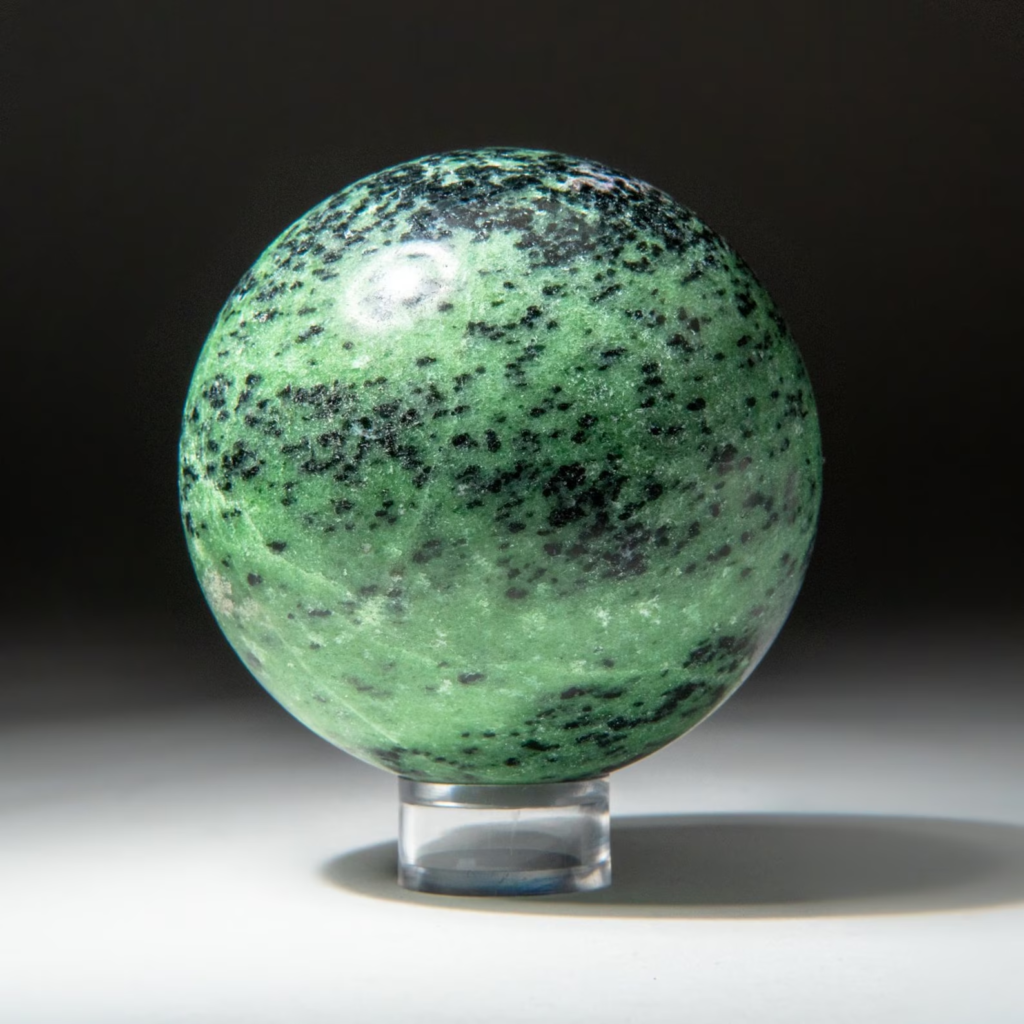
Fuchsite deposits are found in various locations around the world, often associated with specific geological settings. Some notable regions known for their fuchsite deposits include:
- Brazil: Brazil is known for its significant deposits of fuchsite, particularly in the states of Minas Gerais and Bahia. These deposits often occur within metamorphic rocks such as schist and gneiss.
- India: India is another major producer of fuchsite, with deposits found in regions such as Rajasthan and Karnataka. Fuchsite occurrences in India are often associated with metamorphic terrains, including areas of high-grade metamorphism.
- Russia: Fuchsite deposits are found in various regions of Russia, including the Ural Mountains and the Kola Peninsula. These deposits are typically associated with metamorphic rocks formed during regional metamorphism.
- Zimbabwe: Fuchsite is mined in Zimbabwe, particularly in the regions of Mashonaland West and Masvingo. Deposits are often found within metamorphic rocks of Archean age, associated with greenstone belts and granitic intrusions.
- South Africa: Fuchsite occurrences have been reported in South Africa, primarily in the Northern Cape Province. These deposits are typically found within metamorphic rocks of the Namaqualand Metamorphic Complex.
- United States: Fuchsite deposits can be found in various states across the United States, including California, North Carolina, and Colorado. These deposits occur within metamorphic terrains such as schist, gneiss, and marble.
- Australia: Fuchsite has been reported in Western Australia, particularly in regions such as the Pilbara Craton. These deposits are often associated with greenstone belts and other metamorphic terrains.
These locations represent some of the primary sources of fuchsite deposits globally. However, fuchsite may also be found in smaller quantities in other regions with suitable geological conditions for its formation.
Uses of Fuchsite
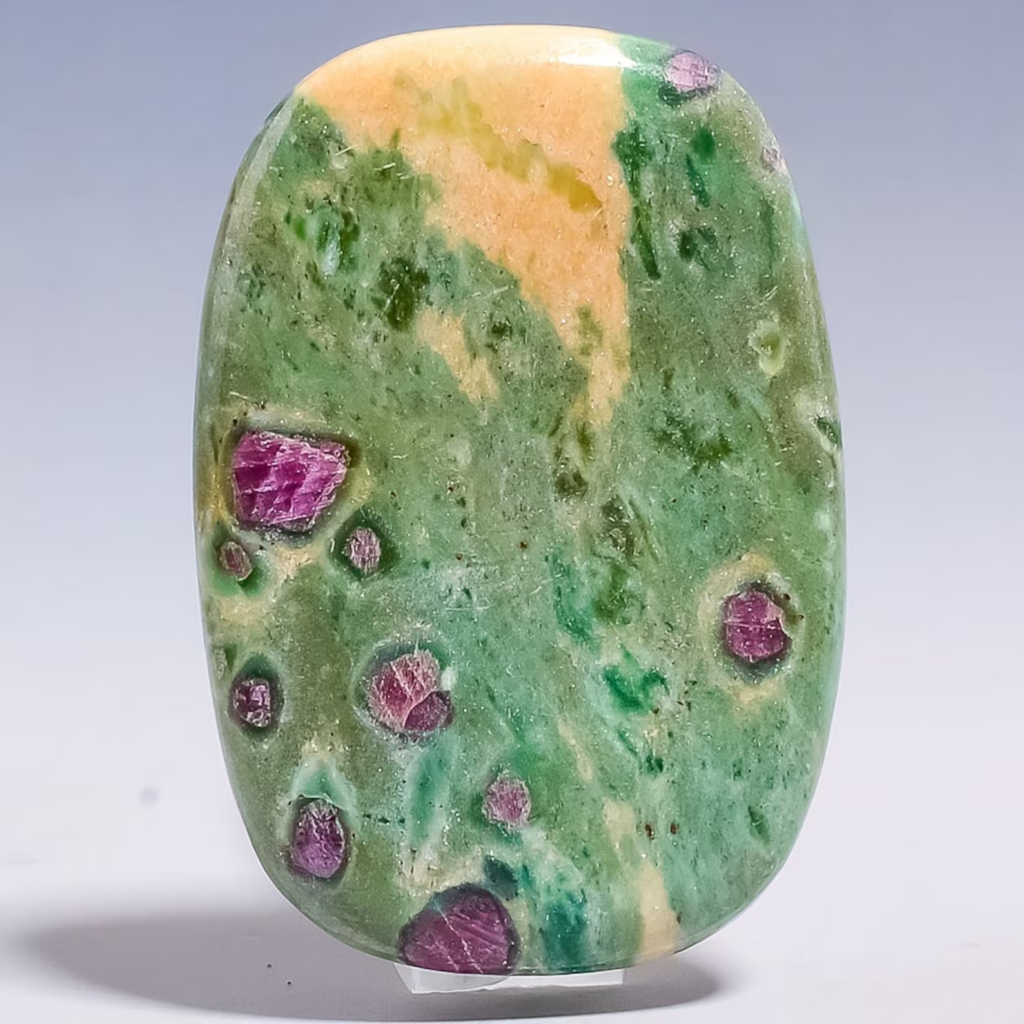
Industrial Applications:
- Cosmetics: Fuchsite is sometimes ground into a fine powder and used as a pigment in cosmetics and personal care products. Its green coloration makes it desirable for products such as eyeshadows, nail polishes, and body glitter.
- Refractory Materials: Due to its resistance to heat and chemical corrosion, fuchsite can be used as a component in refractory materials. These materials are employed in high-temperature industrial processes, such as in the lining of furnaces, kilns, and reactors.
- Electronics: Fuchsite’s properties, such as its electrical insulation and heat resistance, make it potentially useful in electronic applications. It may be utilized as a filler material in electronic components or as a substrate for certain types of circuit boards.
- Lubricants: In some cases, fuchsite has been used as a filler or additive in lubricants due to its lamellar structure, which can provide lubricating properties and reduce friction between moving parts.
Jewelry and Ornamental Uses:
- Gemstone Cabochons: Fuchsite is often cut and polished into cabochons, which are smooth, convex gemstones with a flat bottom and a domed top. These cabochons showcase the mineral’s attractive green color and shimmering appearance, making them popular for use in jewelry settings such as rings, pendants, and earrings.
- Beads and Carvings: Fuchsite may be shaped into beads for use in necklaces, bracelets, and other types of jewelry. Additionally, skilled artisans may carve fuchsite into ornamental objects such as figurines, sculptures, or decorative items.
- Metaphysical and Healing: Fuchsite is believed by some practitioners of crystal healing to possess metaphysical properties that promote emotional balance, abundance, and spiritual growth. As a result, it is sometimes incorporated into healing jewelry or used in meditation practices.
- Collectibles: Some collectors appreciate fuchsite specimens for their aesthetic appeal and geological significance. Collectors may seek out specimens with unique crystal formations or exceptional coloration to add to their mineral collections.
Overall, fuchsite’s distinctive green color, shimmering appearance, and perceived metaphysical properties contribute to its diverse range of uses in industrial applications, jewelry making, and ornamental crafts.
Economic Importance

The economic importance of fuchsite stems from its various applications in industries such as cosmetics, manufacturing, and jewelry. Here are some ways in which fuchsite contributes to the economy:
- Gemstone Industry: Fuchsite is valued as a decorative gemstone due to its attractive green color and shimmering appearance. It is often cut and polished into cabochons or beads for use in jewelry, contributing to the global gemstone trade.
- Cosmetics: Fuchsite is used as a pigment in cosmetics and personal care products such as eyeshadows, nail polishes, and body glitter. Its green color adds aesthetic appeal to these products, and its presence contributes to the cosmetics industry’s revenue.
- Industrial Applications: Fuchsite’s properties, including its heat resistance, electrical insulation, and resistance to chemical corrosion, make it useful in various industrial applications. It is employed in refractory materials, lubricants, and electronics, contributing to the efficiency and functionality of industrial processes.
- Lapidary Arts: Fuchsite is sought after by lapidaries and artisans for its suitability for cutting, carving, and polishing into ornamental objects. The sale of fuchsite jewelry, sculptures, and decorative items contributes to the economy of the arts and crafts sector.
- Metaphysical Market: In recent years, there has been growing interest in the metaphysical properties of minerals like fuchsite. It is believed by some to possess healing and spiritual qualities, leading to its use in alternative therapies, holistic practices, and the sale of metaphysical products.
- Mining Industry: The extraction of fuchsite from deposits contributes to the mining sector’s activities in regions where the mineral is found. This includes employment opportunities in mining operations, as well as revenue generation through the sale of fuchsite-containing ore or processed materials.
Overall, while fuchsite may not be as economically significant as some other minerals, its diverse range of applications in various industries contributes to its overall economic importance. It supports livelihoods in mining, manufacturing, and the arts, while also satisfying consumer demand for jewelry, cosmetics, and metaphysical products.



























